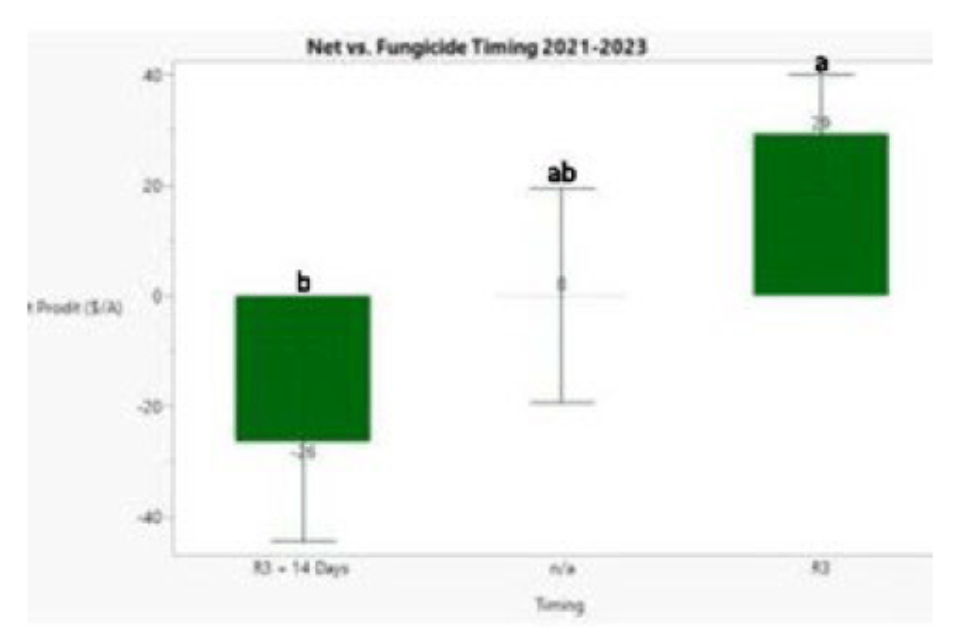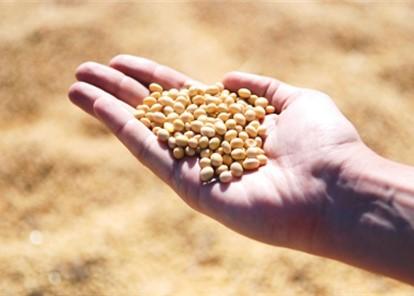2023 Maryland Soybean Fungicide Efficacy Trials
Andrew Kness, Senior Agriculture Extension Agent, University of Maryland Extension
akness@umd.edu
JUSTIFICATION
Fungicides are becoming increasingly popular in full season soybean production. These trials provide data that soybean producers can benefit from, such as: fungicide efficacy for managing common fungal diseases of soybean, monitor fungicide resistant pest populations, and track the economic impact of foliar fungicide applications over multiple years and environments unique to Maryland.
RESEARCH OBJECTIVES
-
Evaluate the efficacy of select foliar fungicides on full season soybeans grown on two research farms in Maryland by measuring foliar disease incidence and severity.
-
Determine any greening or green stem effects of the fungicides.
-
Monitor fungicide active ingredient efficacy over time and identify any fungicide insensitive foliar fungal pathogens.
-
Determine the yield impact of foliar fungicides and their economic impact.
METHODS
Plot Design
Field trials were established at three University of Maryland Research farms: Western Maryland Research & Education Center in Keedysville, MD (WMREC), Wye Research and Education Center in Queenstown, MD (WYE), and Central Maryland Research & Education Center (CMREC). Plots were 11’x30’ arranged in a randomize complete block design with five replicates. Planting details are outlined in Table 1. Plots were planted behind soybeans in order to create conditions conducive for developing foliar diseases on soybean.
Project supported by the Maryland Soybean Board
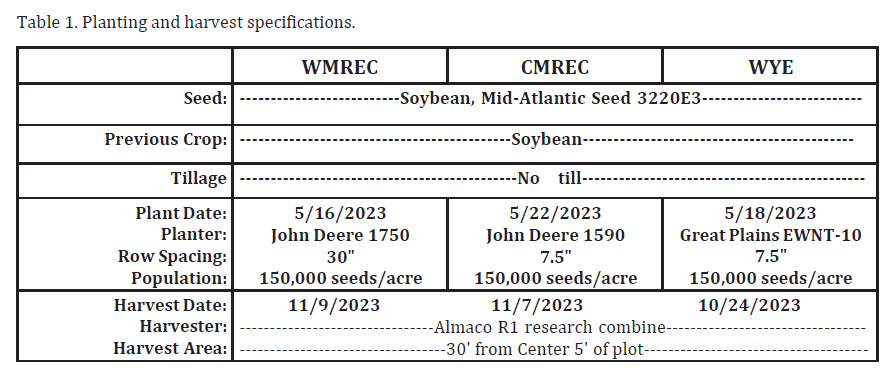
Fungicide Applications
Fungicides (Table 2) were applied at the R3 growth stage (August 9 at WMREC and CMREC and August 2 at WYE) using a CO2 powered backpack sprayer equipped with TeeJet 8003 nozzles calibrated to deliver 20 GPA at 35 psi to the center 80 inches of each plot. Some plots had two fungicide treatments, the first at R3 and the second 14 days later with (R3+14 days). These applications were made on August 16 at WYE and August 23 at WMREC and CMREC.
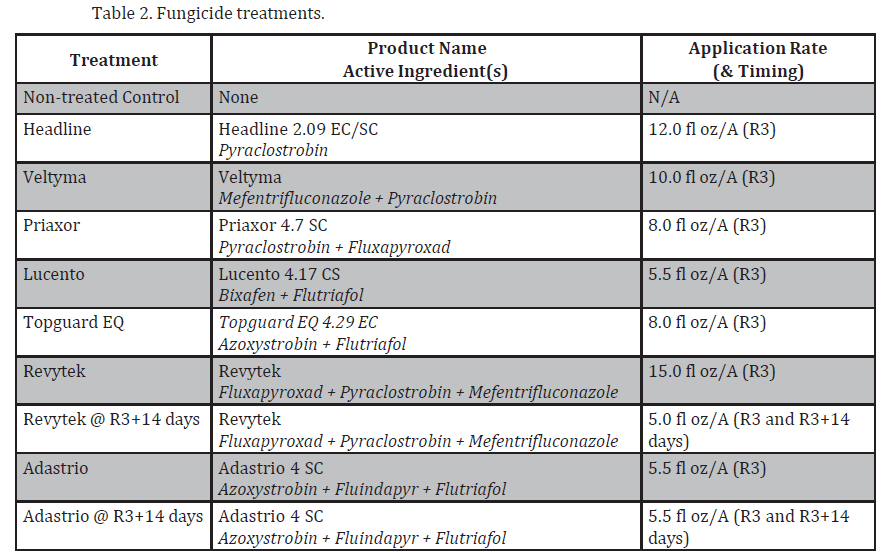
Disease Rating
Foliar diseases were rated prior to fungicide application at R3 and approximately every two weeks following until approximately R6. Disease severity from frogeye leaf spot (FLS; Cercospora sojina) was visually rated as the percent leaf area infected in the upper canopy from the center rows of each plot (four rows for 15-inch row spacing plots and two rows of the 30-inch row spacing plots). Frogeye leaf spot is typically the most prevalent foliar fungal disease in Maryland soybean production.
Harvest and Statistics
Yield data were collected by harvesting the center 5 feet of each plot using an Almaco R1 research combine. All yields reported are adjusted to 13% moisture. Harvest dates are shown in Table 1. Statistics related to profitability and economics were calculated using the local cash market price for soybean of $13.05 per bush- el at the time of analysis. Data were analyzed using ANOVA and significant differences between treatments were separated using Fisher’s Least Significant Difference (LSD; α=0.10).
RESULTS & DISCUSSION
Disease Rating
Growing conditions were generally not favorable for disease development and we did not observe any ratable fungal diseases at any of the three trial locations. This is likely due to the weather conditions around pod fill, as well as the resistance package in the soybean variety; Mid-Atlantic Seed ‘3220E3’ has a frogeye leafspot resistance rating of 6 on a 10-point scale (10 being the most resistant). This is now the third year in a row where no ratable foliar diseases were present in these plots.
Yield
Yields (Figure 1 and Table 2) varied greatly between locations. Yield average at WMREC was 45.5, 61.2 at CMREC, and 74.7 bushels per acre at WYE. Yields at WMREC were suppressed due to the drought in western Maryland. Statistically, there were no significant differences between fungicide treatments and the non-treated control at any of the trial locations (P=0.4331 at WMREC, P=0.6580 at CMREC, and P=0.4056 at WYE). There were also no significant differences in grain moisture or test weight.
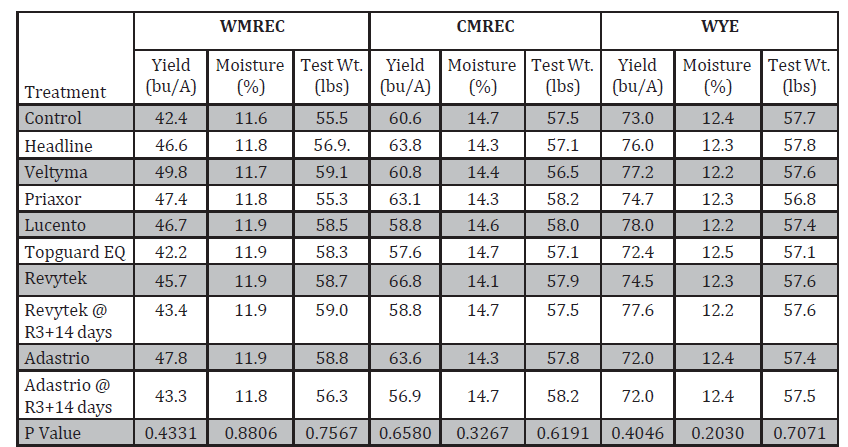
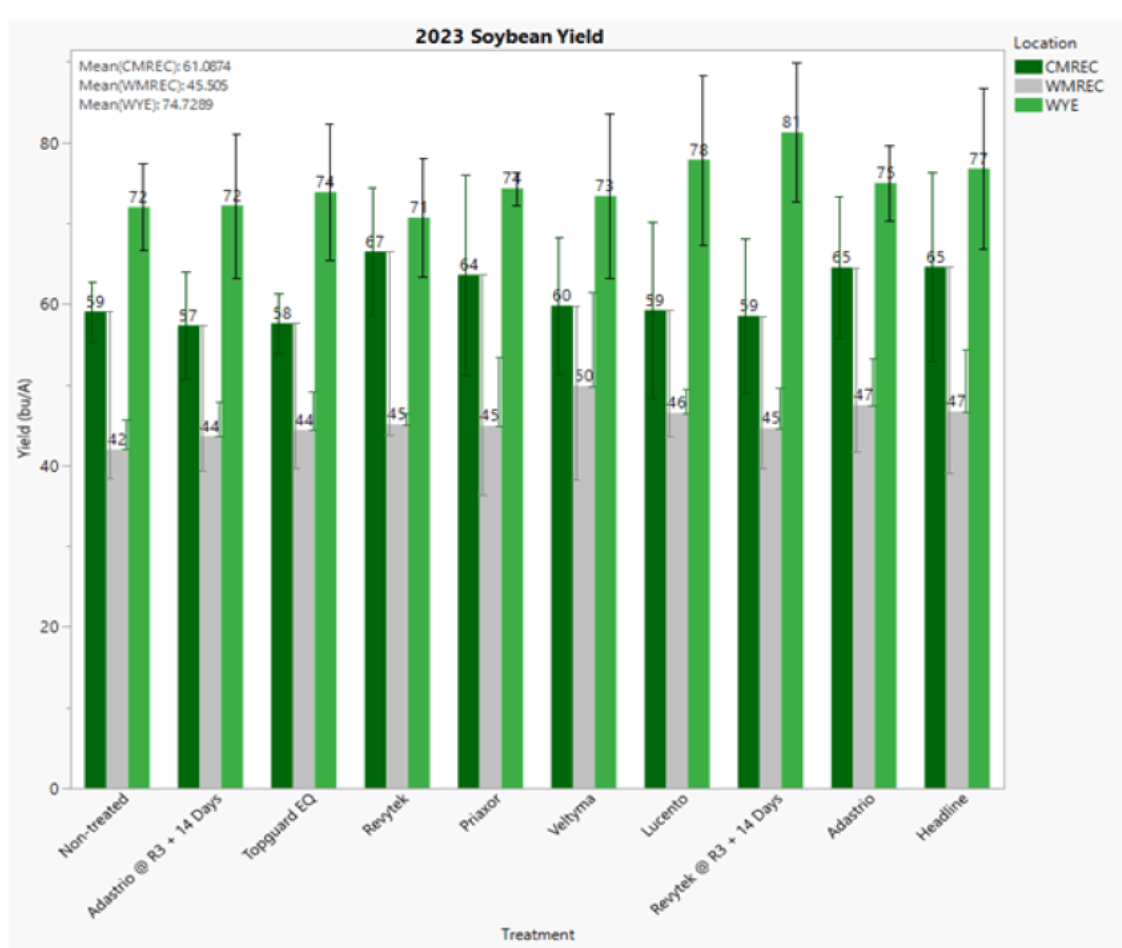
Figure 1. Soybean grain yield by location. Each error bar is constructed using 1 standard deviation from the
mean. No significant differences between treatments at each location (α=0.10).
Since there was a significant difference in yield between locations (P<0.0001), relative yield was calculated and used to compare yields across locations. Relative yield was calculated by dividing the plot yield by the non-treated control plot yield and reported as a percentage. Values greater than 100 represent a yield greater than the control and values less than 100 represent a yield less than the control. When data were combined this way, no significant differences were observed between treatments (P=0.6901, Figure 2).
Green Stem
It is common for fungicides to keep plants greener for longer, and we observed a significant difference in plant greenness prior to harvest in plots that received a fungicide application. Both the single application at R3 and the double application at R3 and R3+14 days significantly increased green stem compared to the non-treated control (p=0.0221).
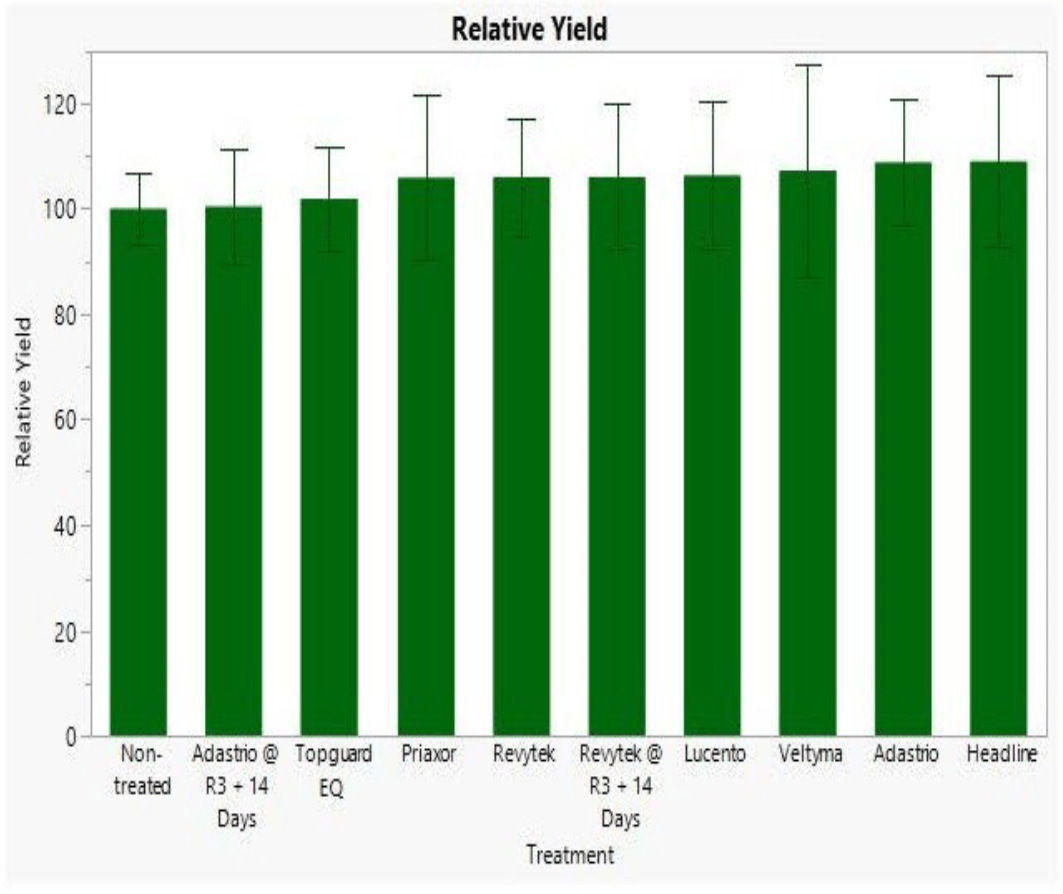
Figure 2. Relative grain yield of all site locations combined. Each error bar is constructed using 1 standard deviation from the
mean. No significant differences between treatments (α=0.10).
CONCLUSIONS, IMPLICATIONS, AND FUTURE WORK
In previous years of this study, foliar fungicide applications with the selected products tested provided some
benefit related to improved seed quality and yield in situations where FLS disease pressure was present at measurable levels (2018-2019). Fungicides also significantly increased plant greenness and delayed senescence.
During the 2023 growing season, however, none of the treatments tested yielded significantly different than the non-treated control. This is likely due to the fact that no ratable foliar fungal diseases were present in the plots this year. Without the presence of a pathogen, fungicides have reduced odds of improving yields over non-treated plots.
Relative net profit was calculated by multiplying the bushel increase over the non-treated control by the cash market price for soybean at the time of analysis (13.05/bu for December 2023) and subtracting the cost of application. A flat rate of $26.00 per acre was used for 2023 data; for plot with two applications, $52.00 was used. This metric, net profit, was used to compare the economics of the fungicides while accounting for yield, market prices, and the cost of application. Figure 3 shows net profit for each treatment; there are no significant differences (P=0.6838).
When net profit was analyzed by treatment timing (R3, R3 + 14, and none) across all years (2021-2023), the single R3 application was provided a significantly greater profit margin ($29/acre) than two treatment program (-$26/acre) and the non-treated control (P=0.0231; Figure 4). These data indicate that a single fungicide application at R3 provides the greatest yield increase and profit margin compared to a two-pass program.
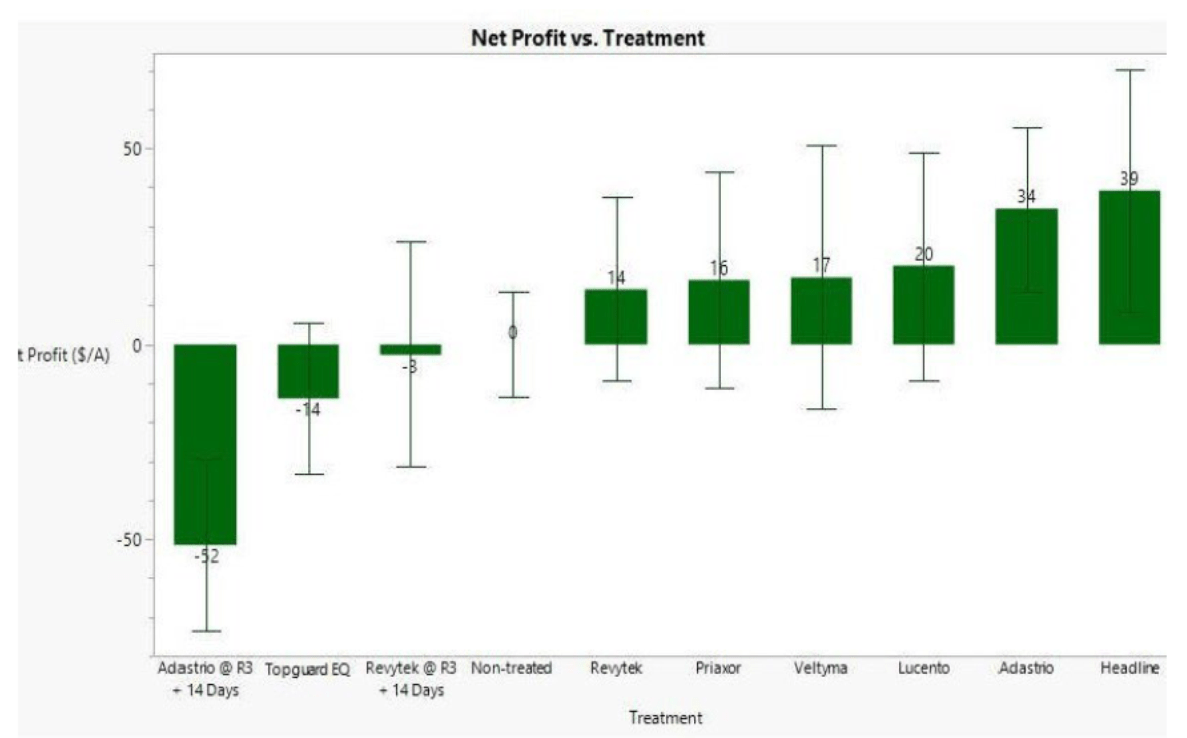
Figure 3. Net profit of 2023 fungicide treatments. Each error bar is constructed using 1 standard deviation from the mean. No significant differences between treatments (α=0.10).
